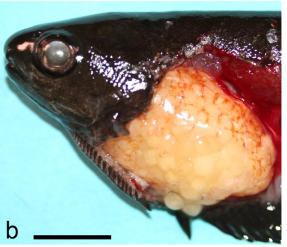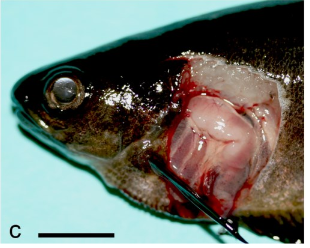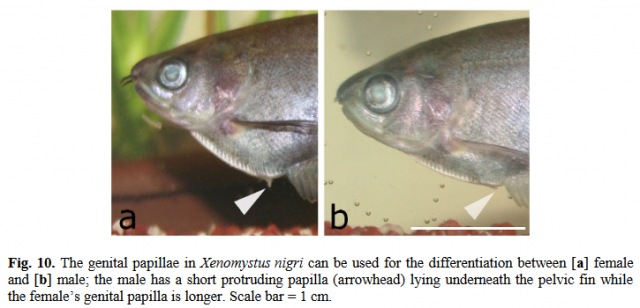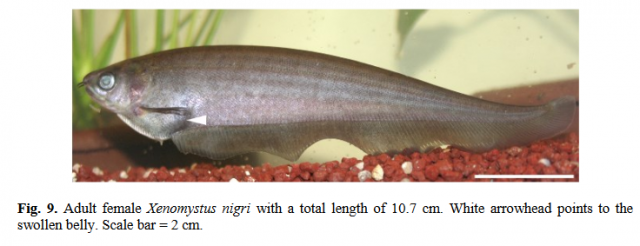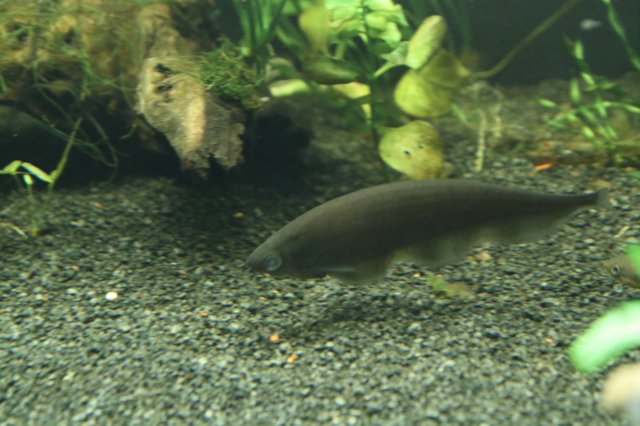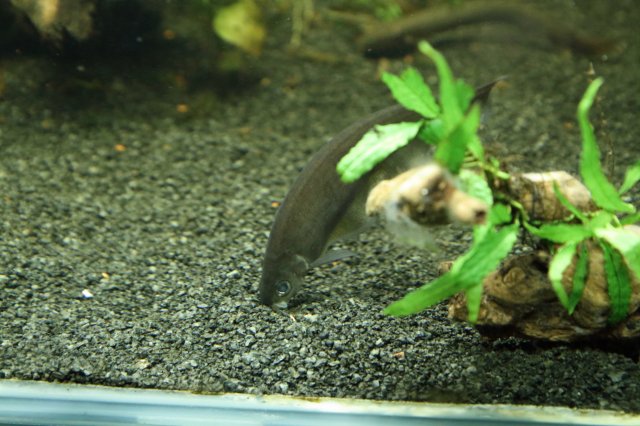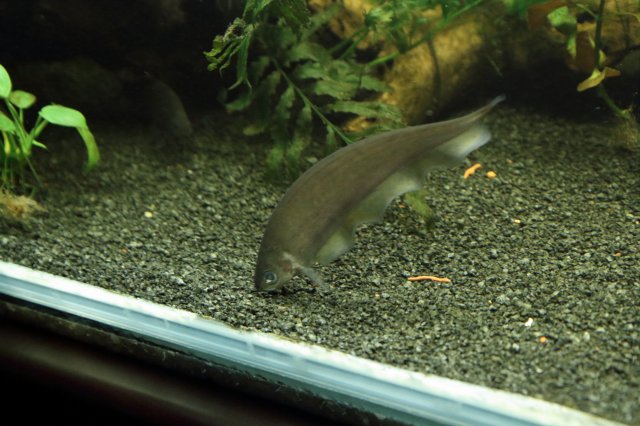Ver2.0 - Various improvements and observations added.
Ver2.1 - Merged with breeding thread to consolidate info, formatted for clarity
African Knife Fish
Family
Scientific Name
Common Name
Origin
Water Parameters
Temperament
Size
Tank Size
Aquarium Set Up
Feeding
Breeding

Quick disclaimer, I had to translate some parts of articles so the English is not 100% on these. Sorry about that
What do we know of their breeding behavior?
The biology of spawning
How to tell the difference?
To summarise
What now?

Photos
Extra notes
List of references and photos
Ver2.1 - Merged with breeding thread to consolidate info, formatted for clarity
African Knife Fish
Family
Notopteridae
Scientific Name
Xenomystus Nigri
Common Name
African Brown Knife
Origin
Africa. Coastal river basins in Sierra Leone, Liberia, Togo, Benin and Cameroon. Also in the Chad, the Nile, the Congo, the Niger (Benue and Niger Delta), the Ogôoué and the Congo (Cuvette Centrale and Ubangui) Basin
Water Parameters
pH 6.0-7.5, Temperature 75`F-84`F (23`C-29`C)
Temperament
Not Aggressive, but don't keep with small fish. Generally ignores tankmates unless it could eat them or doesn't have enough hiding space in which case it may fight.
Size
Average of 8" in aquarium, potential size of 12" in the wild. Biggest I've seen in captivity is 10"
Tank Size
48"x18" (120x45cm) footprint recommend. Height isn't too important, but keep it at least 12" (30cm) tall. A 55-75 gallon is a perfect start
Aquarium Set Up
A well planted and/or dim lit tank is most comfortable for them. Noctural in nature, so it is best to provide lots of hiding spaces. If they are comfortable they will move around in the day, usually close to cover or plants. Make sure there's enough hiding space for them, they really use it. They can be kept in groups and will often hang together in spacious areas of cover, there is often chasing or nipping but never results in damage and is suspected to just be over territory and heirarchy. With enough hiding space there shouldn't be major problems. Sand is also highly preferable as a substrate.
Feeding
Not at all a fussy eater taking pellets, frozen foods, freeze dried foods, live worms, live shrimp, cut fish and prawns. Often reluctant to feed during daytime hours
Breeding
Actual documentation of spawning is extremely rare.
 Oddball
kept a group in a 300+ gallon tank many years ago as a clean up crew with his larger fish. He observed that there were some smaller individuals within his tank, much smaller than the others. A likely indication that they may have bred within his aquarium. Other reports are basically unheard of.
Oddball
kept a group in a 300+ gallon tank many years ago as a clean up crew with his larger fish. He observed that there were some smaller individuals within his tank, much smaller than the others. A likely indication that they may have bred within his aquarium. Other reports are basically unheard of.

Quick disclaimer, I had to translate some parts of articles so the English is not 100% on these. Sorry about that
What do we know of their breeding behavior?
Luckily there are more reports of them enagaging in courtship behaviour, and it is interesting indeed.
My first source, a study Reproductive styles of Osteoglossomorpha, found that after the injection of hormones the pairs
My first source, a study Reproductive styles of Osteoglossomorpha, found that after the injection of hormones the pairs
A German aquarist gave a similar but more detailed account of the behaviourThe pairs indeed were seen
swimming very closely to each other during day time. In fact, double of the
concentration of the regular hormonal injection was given on the last day (day 415) of
the trial to all of the selected specimens, however still nothing happened
Well I see once in a while, like these animals on the side together but not head to head. The male puts his head in the rear flank of a female here and stubs it more often with a bobbing motion.
There is a similar position, no matter whether male or female, and the animals start loud barking, where they squeeze air from their swim bladder into the anterior intestine. This bark is easily audible and has been reported to awaken sensitive people from their sleep.
Somebody uploaded videos of similar behaviour:
Barking is commonly associated behaviour of courting knifefish.
A third article gave some minor detail on wild spawning:
In the wild, the females lay 150-200 eggs in a shallow well, where they are then fertilized by the male. The male takes up tending to the eggs and he fans the eggs constantly with fresh water.
This coincides with seriouslyfish's writeup:
This means they likely set up a spawning site and defend it until the fry have hatched
Colour changes have also been noted during summer heating periods.
The biology of spawning
The article Reproductive styles of Osteoglossomorpha gives the most comprehensive descriptions and images of the reproductive biology of xenomystus nigri and will be used as my source of reference in this article. Here is a summary of the initial process:
The first 16 (9, 7
) fish arrived on 30 March 2009 and comprised a range in total
length of 85–120 mm. The fish, originating from the Niger Basin, were
purchased from a wholesale dealer. This group was placed in a tank measuring
120 x 75 x 60cm and one third of the water was regularly changed once a week. The first tank was furnished with black polyethylene shreds as hiding substrates. Two weeks upon arrival, some of the fish were infected with the ectoparasite Ichthyiophthirius (known as white spot disease). Medicinal treatment was performed for
three weeks, although three heavily infected fish died. The remaining fish recovered well. Acclimation was continued in a disinfected tank for about 60 days.
The second group was purchased on 6 May 2009 fr
om a wholesale dealer consisting of 10 specimens(9,1
) with a total length of 128–173 mm. The specimens were placed into a tank measuring 90 x 60 x 53cm, which was also supplied with black polyethylene shreds and two PVC tubes as hiding places. Acclimation period lasted about three months. . Fish were fed once daily with live Chaoborus sp. and/or frozen chironomids. Selected specimens with swollen bellies received several hormonal injections.
Three tanks (90x60x53cm) were furnished with several PVC tubes, stones and woods. Each of tanks comprised one male and female. The selected specimens were separated for two weeks before the injection. Immediately after the injection, all specimens were returned into their previous tanks.
Female knives were observed with swollen bellies between days 34-70 but no spawning occured, even with triple hormone dosage. The ovaries and testes are positioned in the front of the body just behind the head
The females started swelling at a greater weight when the conductivity dropped, but no spawning happened. The conductivity ranged widely and the pH was shifted between 6.6-8.2 over the months but nothing happened still.
Fry are said to be fairly large at hatching and can start on baby brine shrimp or similar organisms.
Fry are said to be fairly large at hatching and can start on baby brine shrimp or similar organisms.
How to tell the difference?
This would mean I own 2 males, the gonad is very reduced on males so look carefully. It seems to become more pronounced as they mature.
Only presumed females were observed with eggs so I would believe it to be accurate.
Only presumed females were observed with eggs so I would believe it to be accurate.
To summarise
Xenomystus nigri appear to be breedable with the reports of courtship and swelling of eggs, but the exact trigger of spawning has yet to be found and Is something I would like to look into. Hopefully one day somebody will be able to crack the enigma that is preventing their spawning in captivity.
What now?
Breeding African knife fish will be a major breakthrough for the hobby, and would allow us access to captive bred specimens. Good news for the wild populations and the hobby as a whole, one day I will hope to see CB specimens in the shops.
For anyone aspiring to breed these fish here is a summary of things that appear to be important:
I hope this article is interesting or helpful for all those interested in knife fish. For anyone aspiring to breed these fish here is a summary of things that appear to be important:
- Low conductivity in the water.
- Frequent feeding of live and or frozen foods.
- A large share of hiding spaces for security.
- Softer water with a pH between 5.5-7.5
- A sandy substrate or wood as spawning sites.
- Temperature of 26-28 celsius (79-82F).
- A mixed group of males and females.
- A good attitude and perseverance
Photos
Extra notes
After keeping in various environments it appears these knives do best in a dark tank and are much more active with a black background and substrate with lots of décor to hide around. They will breathe air periodically and all of the 4 knives in my tank breathe under the output of my HOB filter. They also have favourite hiding spots in the tank which differ by fish. Lastly they do best with peaceful tankmates, cichlids tend to bully them unfortunately. Large tetras, leopard bush fish, large tetras, synodontis catfish and such are quite ideal 
I hope this proves valuable to anyone who reads this, these are definitely one of the best knives in the hobby 
List of references and photos
http://edoc.hu-berlin.de/dissertationen/yanwirsal-honesty-2013-05-16/PDF/yanwirsal.pdf
http://www.seriouslyfish.com/species/xenomystus-nigri/
 Oddball
Oddball
https://www.aquaristikfreaks.de/fishbase/Xenomystus_nigri.html
https://www.aquariumforum.de/threads/149885-xenomystus-nigri
http://wasser-landexoten.de/afrikaner/westafrika/xenomystus-nigri-der-afrikanische-messerfisch/
http://www.aqua4you.de/fischart1054.html
http://www.seriouslyfish.com/species/xenomystus-nigri/
https://www.aquaristikfreaks.de/fishbase/Xenomystus_nigri.html
https://www.aquariumforum.de/threads/149885-xenomystus-nigri
http://wasser-landexoten.de/afrikaner/westafrika/xenomystus-nigri-der-afrikanische-messerfisch/
http://www.aqua4you.de/fischart1054.html
Last edited by a moderator:




